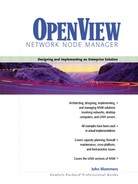Introduction
Network Node Manager may do hundreds of forward and reverse lookups at a busy time as it goes about the business of discovery, configuration management, and status checking. This requires a reliable, accurate, high-performance Domain Name System (DNS). This chapter reviews the operation and configuration for DNS as it is assumed the reader is already familiar with it.
DNS is a critical, heavily-used resource for NNM. DNS efficiently provides name-to-address (forward) lookups as well as address-to-name (reverse) lookups that are critical to NNM’s configuration management.
Before DNS there was /etc/hosts, a simple linear file containing the names and IP addresses of networked systems. The size and distribution problems associated with this file proved a serious limit to scalability.
DNS provides explicit support for multihomed devices such as routers and servers with multiple network adapters. An address lookup for a multihomed device returns all the IP addresses associated with it, which in the case of a router, can be considerable.
DNS offers a number of reliability features to ensure the service is always available to client systems (such as NNM). These include multiple name servers at the client, caching, primary and secondary servers, and a hierarchy of name servers to delegate authority.
Delegation in DNS allows local authoritative name servers to be maintained by local network administrators all over the enterprise network, yet, from the client perspective, the information seems to come from the local name server. For large corporations with multiple independent business locations, DNS fits well.
Sample configuration files for the DNS client as well as the DNS server (for UNIX) are given in this chapter. BIND version 8 is assumed, and the sample files are real, having been tested on the author’s own Red Hat Linux system.
Given that DNS is mission-critical, name servers must not become overloaded. Happily, the implementation is very efficient, but it’s highly recommended that an NNM system run a caching-only name server to avoid needless network traffic.
To ensure that DNS servers are available at all times with accurate information, secondary name servers can be set up to copy domain data from the primary name servers. This helps keep down the loading on the primary name servers as well.
At the end of this chapter there is a comprehensive diagram that shows the architecture of a large DNS implementation. It shows the root name servers that glue the primary name servers together, the secondary name servers that feed from them, and the DNS client systems that use these servers.
For a complete guide to DNS, refer to DNS and BIND, Third Edition, by Abitz and Liu, O’Reilly & Associates Inc., ISBN 1-56592-010-4.
